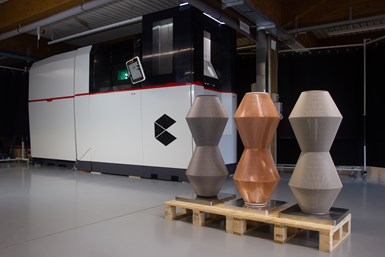Sintavia Expands Rocket Manufacturing Capability with Customized AM Printers
For most existing commercial rocketry in production, the M4K-4 can manufacture an entire thrust chamber assembly as a single unit, including optimized regenerative cooling passages, thereby dramatically reducing manufacturing complexity and time.
Share
Read Next

The AMCM M4K-4 has a one-meter tall build height with four 1 kW lasers (Photo: AMCM GmbH)
Sintavia, a designer and additive manufacturer (AM) of critical thermal components for the aerospace, defense & space industry, is acquiring two M4K-4 printers from Additive Manufacturing Customized Machines (AMCM) of Starnberg, Germany. Each of the two new M4K-4s (which are stretched versions of the EOS M400-4 printer) uses four 1 kW lasers to print single-unit components with dimensions of 450 mm × 450 mm × 1 m.
As one of the largest rocket printers in North America, Sintavia will use the new machines to expand its portfolio of thrust chamber design and manufacturing for the rapidly growing commercial space industry.
“Since the acquisition of our first M400-4 three years ago, Sintavia has devoted tremendous resources to developing successful and repeatable operating procedures for the quad laser printing of extremely thin walls, such as those found in the thrust chamber of a rocket,” says Brian Neff, Sintavia’s chief executive officer. “We now have eight M400-4 quad laser printers, and we expect that the successful strategies employed on the M400-4 will likewise work on these new M4K-4 units.”
Developed by AMCM, an affiliated company of EOS, the M4K-4 is a stretched and widened version of the EOS M400-4 printer, with more powerful lasers and an upgraded cooling system. The design of the M4K-4 was driven largely by demand from commercial space launch customers who were looking to optimize thrust chamber assemblies with fewer traditional joining steps.
For most existing commercial rocketry currently in production, the M4K-4 is able to manufacture the entire thrust chamber assembly as a single unit, including optimized regenerative cooling passages, thereby dramatically reducing manufacturing complexity and time. The two new printers will be delivered in June and July 2021, and will be installed in high-performance copper and nickel alloys.
Related Content
-
Video: 5" Diameter Navy Artillery Rounds Made Through Robot Directed Energy Deposition (DED) Instead of Forging
Big Metal Additive conceives additive manufacturing production factory making hundreds of Navy projectile housings per day.
-
Additive Manufacturing Is Subtractive, Too: How CNC Machining Integrates With AM (Includes Video)
For Keselowski Advanced Manufacturing, succeeding with laser powder bed fusion as a production process means developing a machine shop that is responsive to, and moves at the pacing of, metal 3D printing.
-
What Is Neighborhood 91?
With its first building completely occupied, the N91 campus is on its way to becoming an end-to-end ecosystem for production additive manufacturing. Updates from the Pittsburgh initiative.














